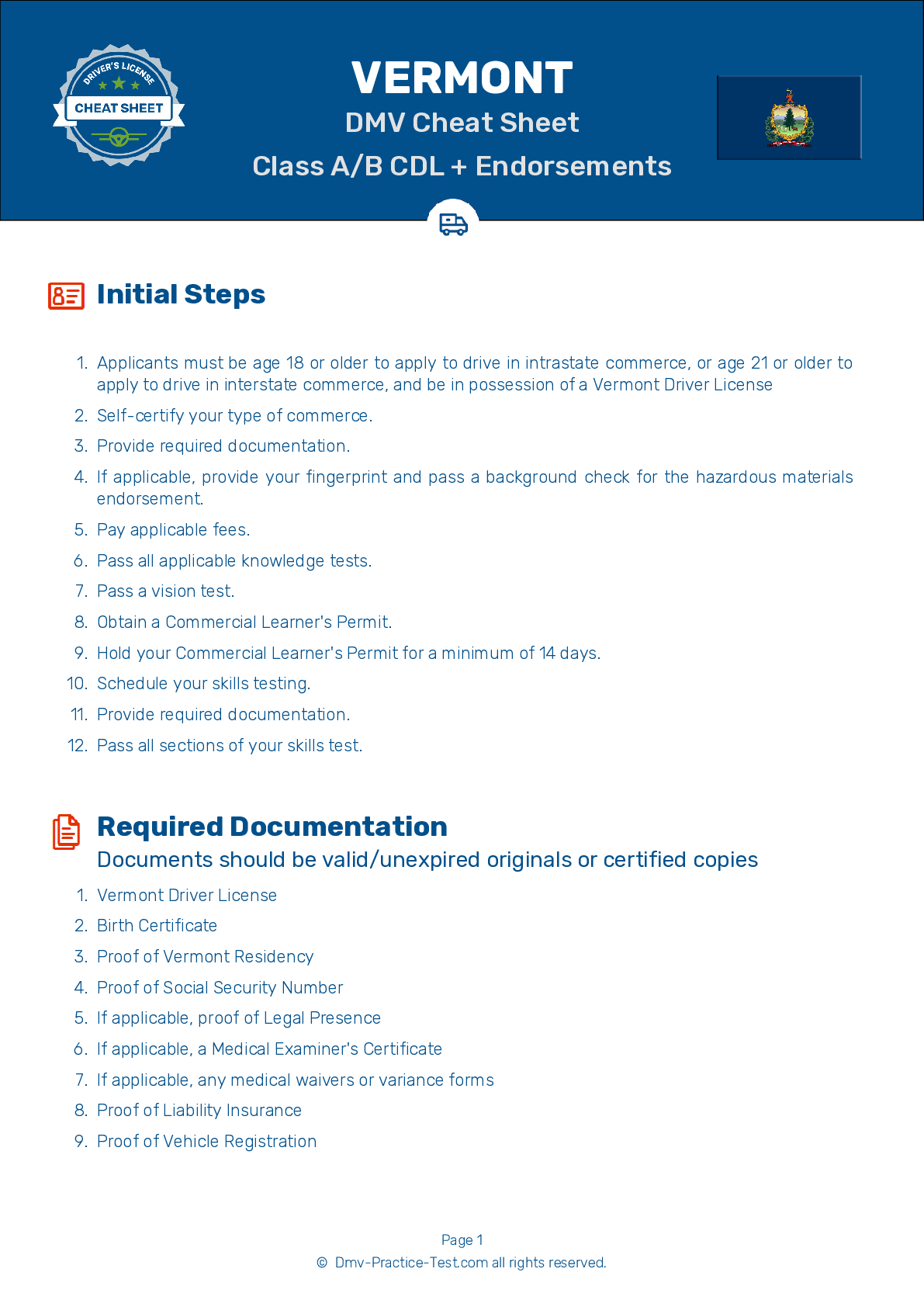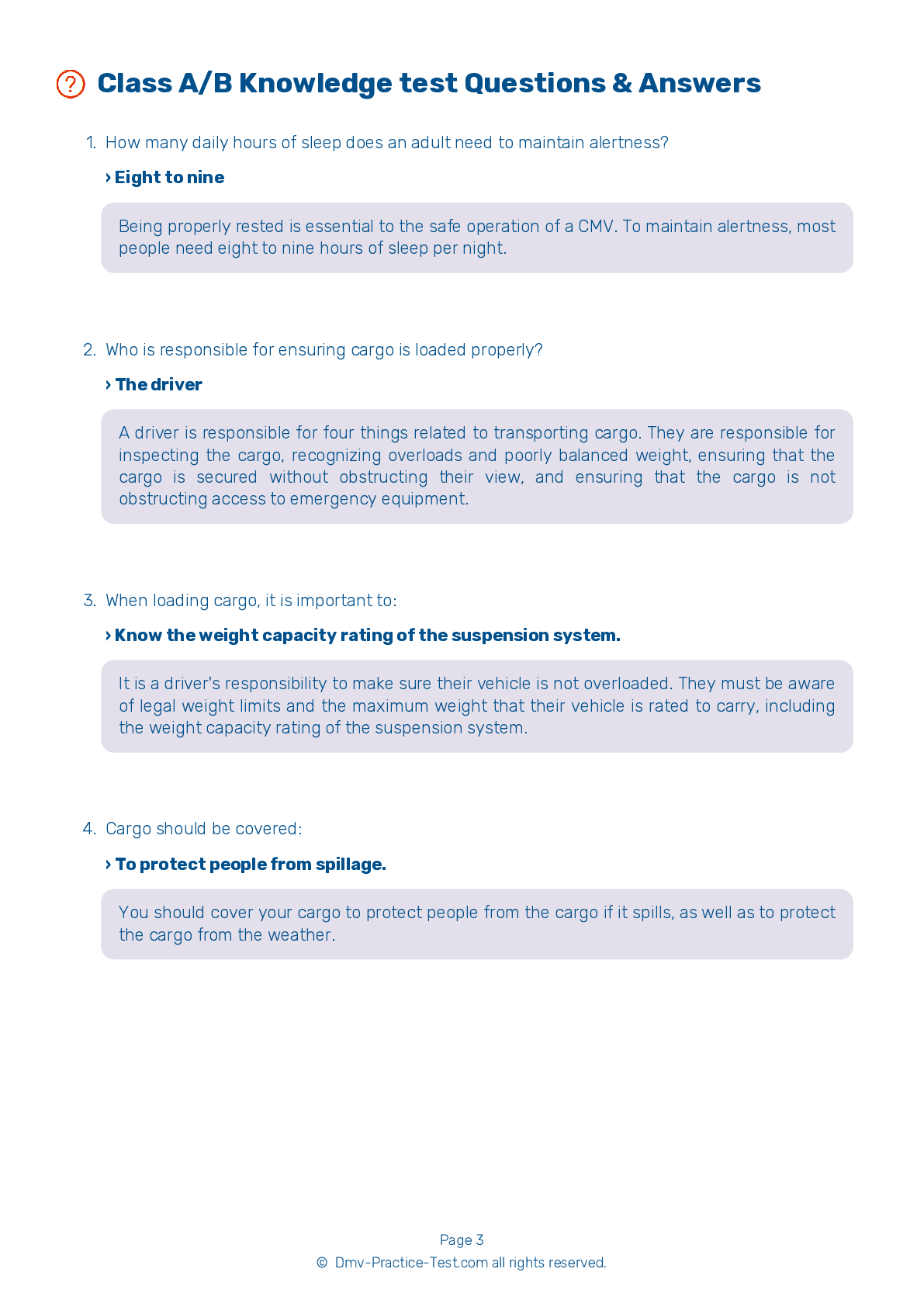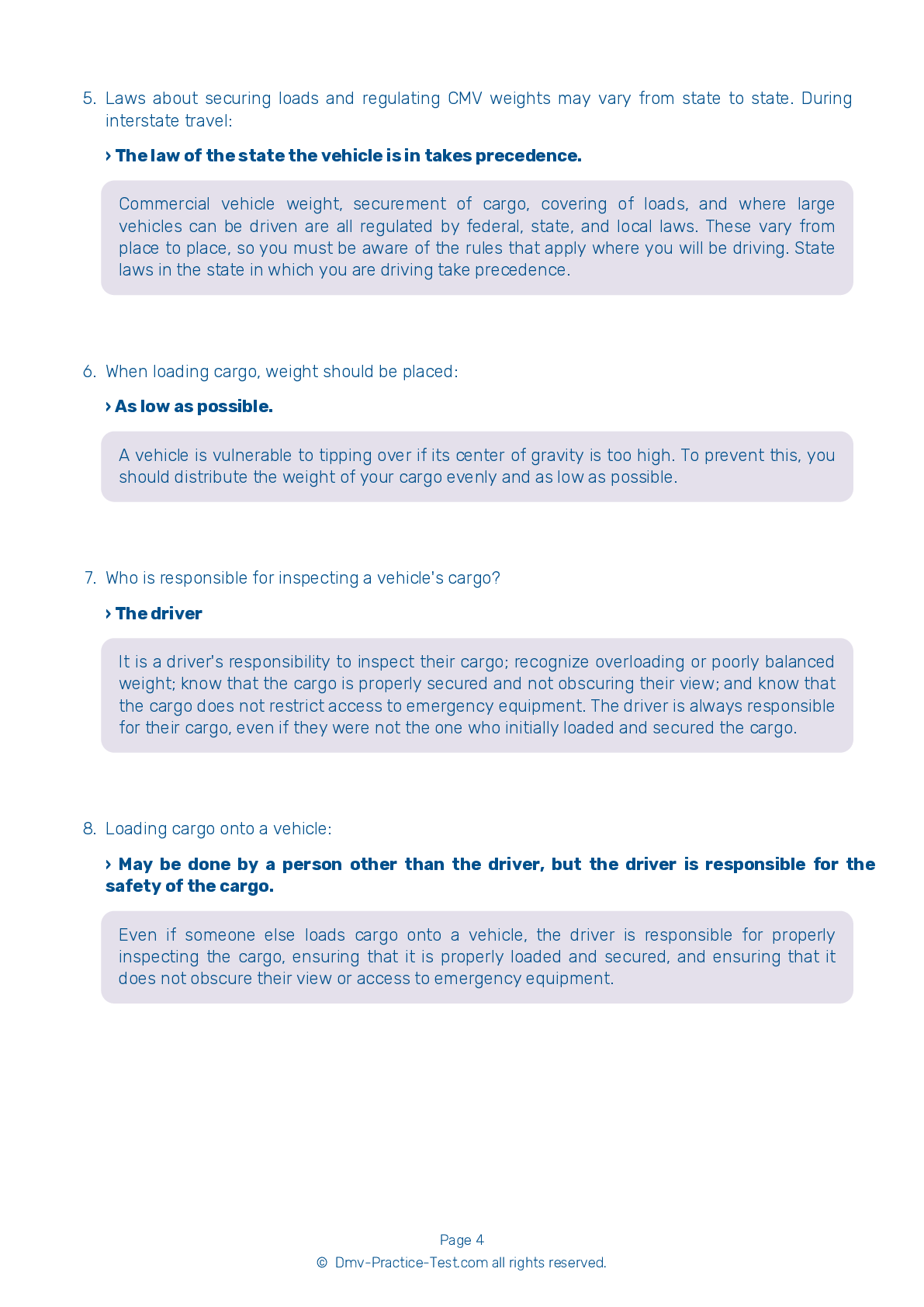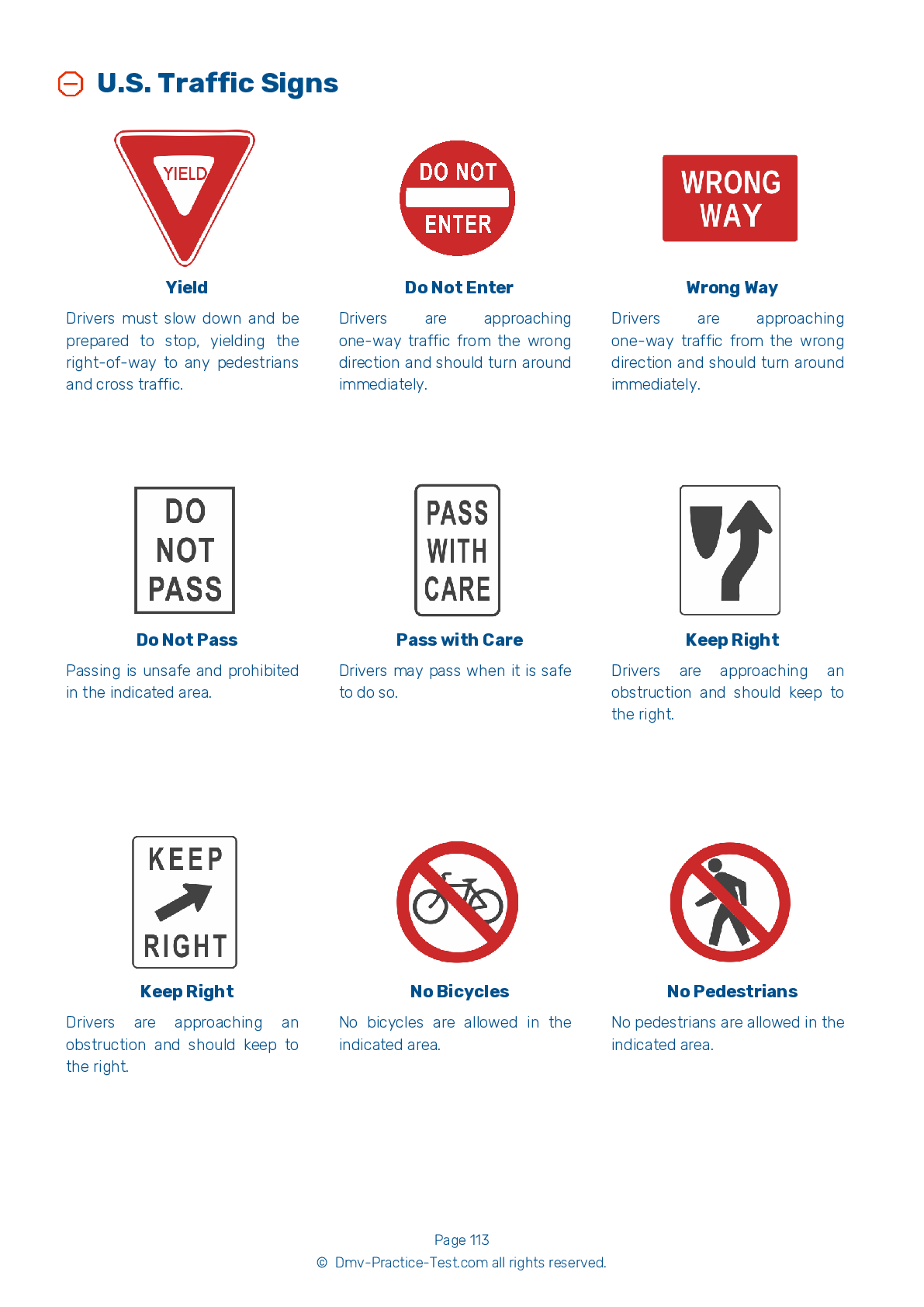Knowledge Test Class B #1
Class B Driving Test | Vermont 2025 #1 Page 7 of 7
Train for FREE online with our Vermont class B license test. The official exam test consists of several obligatory parts, with all of them checking your knowledge of different blocks of road rules. If you need to obtain a VT CDL class B permit in 2025, practice as much as possible. Free sample tests published on our website will help you check and improve your knowledge and boost your grades. Please bear in mind that CDL class B requirements may vary from state to state.
50
40
20
43 . When approaching your vehicle as part of a pre-trip inspection, seeing fresh oil underneath the vehicle is:
When approaching your vehicle, you should check under the vehicle for fresh oil, coolant, grease, or fuel leaks. Spotting any of these before a trip is a cause for concern.
44 . Most heavy trucks with manual transmissions require ____ to change gears.
Most heavy vehicles with manual transmissions require double clutching to shift gears. Learning to effectively change gears by double clutching takes practice.
45 . Without engine oil:
It is critical that an engine have sufficient oil pressure. The engine can be destroyed rapidly if run without oil.
46 . When checking tires, which of the following should not cause concern?
When checking the tires as part of a pre-trip inspection, make sure the tires have sufficient tread. There should be at least 4/32 of an inch of tread in every major groove of the front tires, and at least 2/32 of an inch of tread depth on the other tires. Tires should not be mismatched in size and radial and bias-ply tires should not be used together.
47 . How many daily hours of sleep does an adult need to maintain alertness?
Four to five
Being properly rested is essential to the safe operation of a CMV. To maintain alertness, most people need eight to nine hours of sleep per night.
48 . Which of the following is not a type of tie-down equipment?
You must use the proper number of tie-downs when securing cargo on a flatbed trailer. Examples of tie-down equipment includes ropes, straps, and chains.
49 . When loading a trailer, you should:
A load of cargo must be properly balanced. Placing too much weight over an axle can damage the axle and make it more difficult for you to steer. Placing too little weight over an axle can cause poor traction, also leading to difficult handling.
50 . Why do large vehicles use air brakes?
If used and maintained properly, air brakes are a safe and effective way to stop large, heavy vehicles.
2025 Vermont | Frequently Asked Questions
To secure a CDL Bus endorsement in Vermont, you need to have a valid Commercial Driver's License (CDL). You then need to pass the passenger endorsement knowledge test and the school bus endorsement knowledge test. After passing these tests, you must successfully complete a skills test in the type of school bus you will be driving.
To obtain a CDL Bus license in Vermont, you must have a valid driver's license and pass the CDL general knowledge test. Then, you'll need to get a Commercial Learner's Permit (CLP) and practice on public roads with a qualified CDL holder. After that, pass the CDL skills tests, which include vehicle inspection, basic controls, and road test.
While Vermont doesn't explicitly require specific training for a CDL Bus endorsement, it's highly recommended. Training can help you pass the written knowledge tests and the skills test, which includes pre-trip vehicle inspection, basic vehicle controls, and on-road driving. Experience in driving similar vehicles can also be beneficial.
CDL Bus licenses in Vermont are classified under Class B or Class C. Class B CDL is for single vehicles like city buses. Class C CDL is for vehicles designed to transport 16 or more passengers, including the driver, not covered by Class B. Each class requires passing specific written knowledge tests and skills tests related to the type and size of the vehicle.
No, you cannot use your personal vehicle for the CDL Bus driving test in Vermont. The vehicle used for the test must match the class and type of vehicle you will be driving with your CDL. For a bus endorsement, this means using a commercial bus of the correct capacity and type.
The CDL Bus driving test in Vermont evaluates skills like pre-trip vehicle inspection, basic vehicle control, and on-road driving. You may be asked to perform maneuvers such as backing up, parallel parking, or docking in a designated area. On-road driving evaluates your ability to handle intersections, railway crossings, curves, and various traffic conditions.
Yes, additional medical prerequisites are required for a CDL Bus endorsement in Vermont. Applicants must pass a Department of Transportation (DOT) physical examination every 24 months. This exam assesses general physical health, vision, hearing, and the potential presence of other conditions that could affect driving ability, such as diabetes or high blood pressure.
No, it's not permissible to transport passengers without a valid CDL Bus endorsement in Vermont. The endorsement is required for drivers who wish to operate a vehicle designed to carry 16 or more passengers, including the driver. Driving without the proper endorsement can result in legal penalties, including fines and suspension of your CDL license.
The CDL Bus endorsement can be added to your existing CDL license in Vermont. You don't need to apply for a new license altogether. However, you will need to pass the Passenger Endorsement Knowledge Test and a skills test in the vehicle type you wish to be endorsed for. Ensure to have your current CDL when you apply for the endorsement.
Yes, there are restrictions for drivers with a CDL Bus endorsement in Vermont. Drivers must comply with federal hours of service regulations, which limit driving hours to prevent fatigue. Also, drivers must pass a physical exam every two years and are subject to random drug and alcohol testing. Additionally, any traffic violations or accidents can result in the suspension or revocation of the endorsement.



